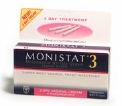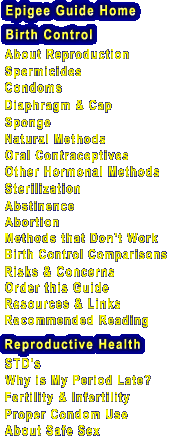

Epigee Recommends
Monistat 3
in association with Amazon.com

Woman to Woman:
Your Body and Your Health
YEAST INFECTION
Yeast normally grows in harmless amounts in the vagina, rectum, digestive tract and mouth. When your system is out of balance, these organisms may grow profusely, causing burning, itching and discomfort. In the vaginal tract, candidiasis, or yeast infection, may cause a thick, white discharge which may look like cottage cheese and smell like bread, although no discharge may be apparent. It can also be transmitted and retransmitted from your sexual partner, as the yeast may live under the foreskin. Yeast infection is commonly recurrent.
Common causes include:
- Hormonal changes due to pregnancy or
- Hormonal changes before monthly periods
- Taking hormones or birth control pills
- Taking antibiotics (especially "broad spectrum" ones)
- Taking steroid medicines, such as prednisone
- Having elevated blood sugar such as found in uncontrolled diabetes
- Vaginal intercourse (especially with inadequate lubrication)
- Douching
| In babies, yeast may grow in the mouth and cause white spots on the inside of the cheeks called thrush. If breastfeeding, the thrush may then infect the breasts of the nursing mother causing pain and/or bleeding. Thrush may also be a problem in those with compromised immune systems, such as the elderly or persons with AIDS. |
Yeast infection is treatable with over-the-counter medication, such as Monistat, or a one-dose medication by prescription (Diflucan), as described below. The STD trichomoniasis can easily be mistaken for a yeast infection, so you should check with your doctor if this is the first time you have symptoms.
Common treatments:
- Over-the-counter creams or suppositories
, usually available in 1, 3 or 7 day regimens (Note: the creams are more effective than the suppositories)
- One-dose medication by prescription (Diflucan)
- Acidophilus tablets
(natural remedy)
To help prevent vaginal yeast infection:
- Practice good hygiene. Wash regularly to clean the inside folds of the vulva where germs are likely to grow.
- Dry the vaginal area thoroughly after you shower or bathe.
- Wipe from front to back after using the toilet.
- Do not use other people's towels or washcloths.
- Wear all-cotton underwear.
- Launder underwear in hot water. Do not use a fabric softener in the dryer.
- Don't wear slacks and shorts that are tight in the crotch and thighs or other tight fitting clothing.
- Change swimwear and workout clothes right away after swimming or exercising.
- Shower after you swim in a pool to remove the chlorine from your skin. Dry the vaginal area thoroughly.
- Use unscented tampons or sanitary pads, and change tampons and sanitary pads frequently.
- Avoid irritating soaps or perfumes as well as talcum powder.
- Take antibiotics only when necessary.
- Eat well and include food products such as yogurt that contain live cultures of lactobacillus acidophilus.
- Get plenty of rest to make it easier for your body to fight infections.
- During sex, use a sterile, water soluble jelly (e.g. K-Y Jelly
).
- Make sure your sexual partner is clean. Ask him to wash his penis and hands before touching you. Use a condom when you are infected.
- Avoid sexual intercourse that is painful or abrasive to your vagina.
- Avoid frequent douching.
- If using hormonal contraceptives, such as birth control pills, try switching to a non-hormonal method.
![]()
- At this site
- The following links are provided as an informational resource or counterpoint and are not necessarily endorsed by the author:
- About Chronic Candidiasis
: At Drugstore.com
- The Candida Page
- National Candida Society (UK)
- About Chronic Candidiasis

Go to Reproductive Health Home

